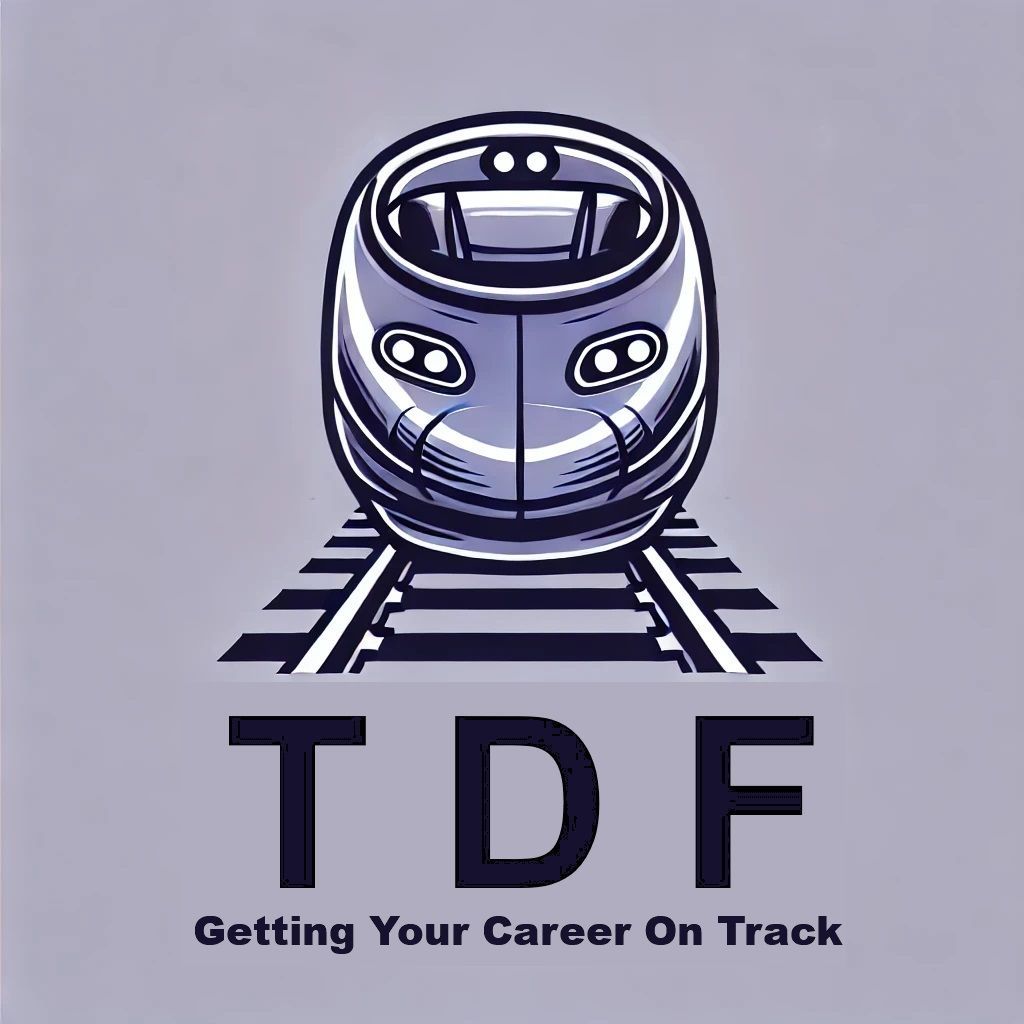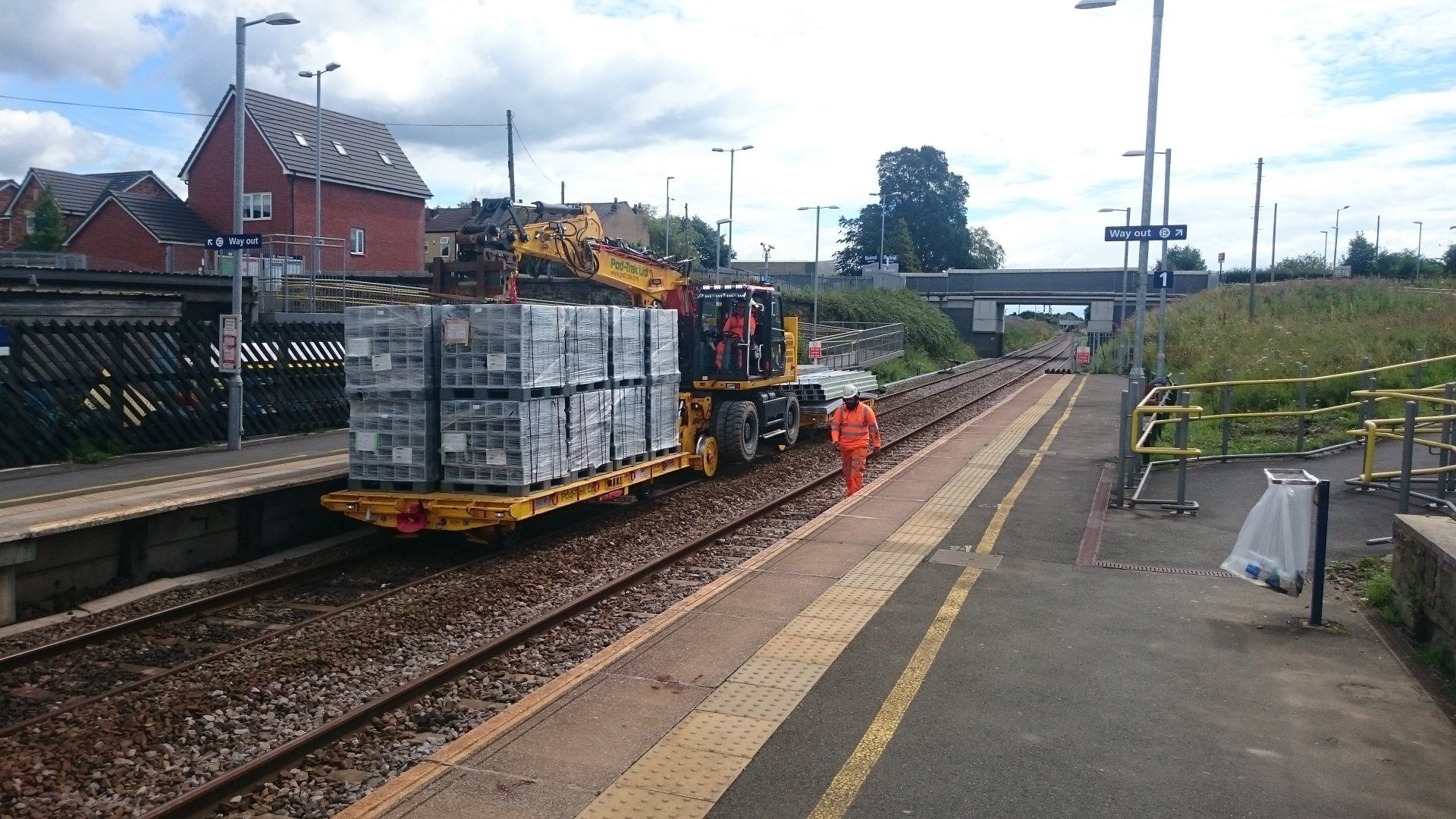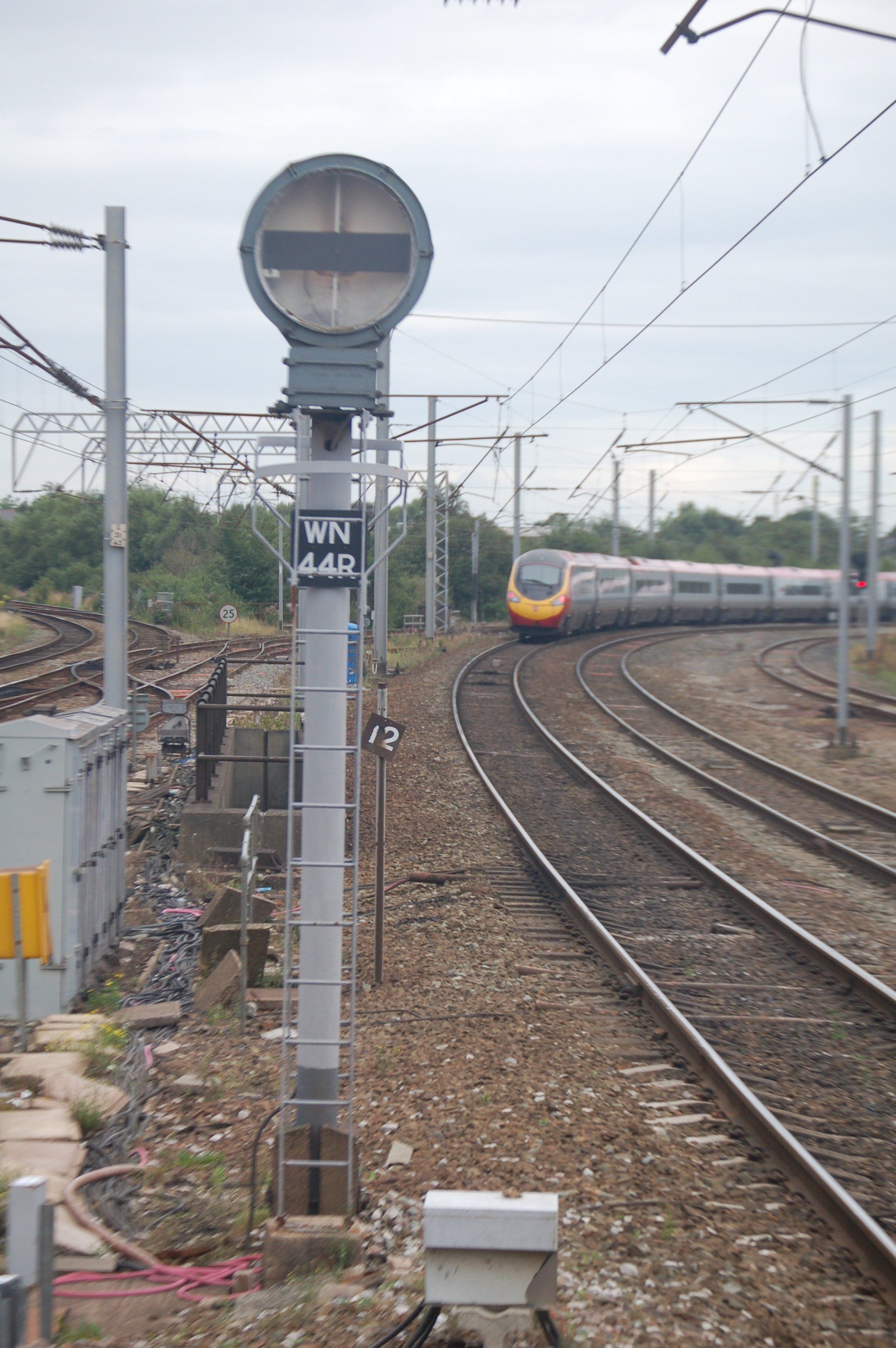Everything you need to know:
Train Drivers
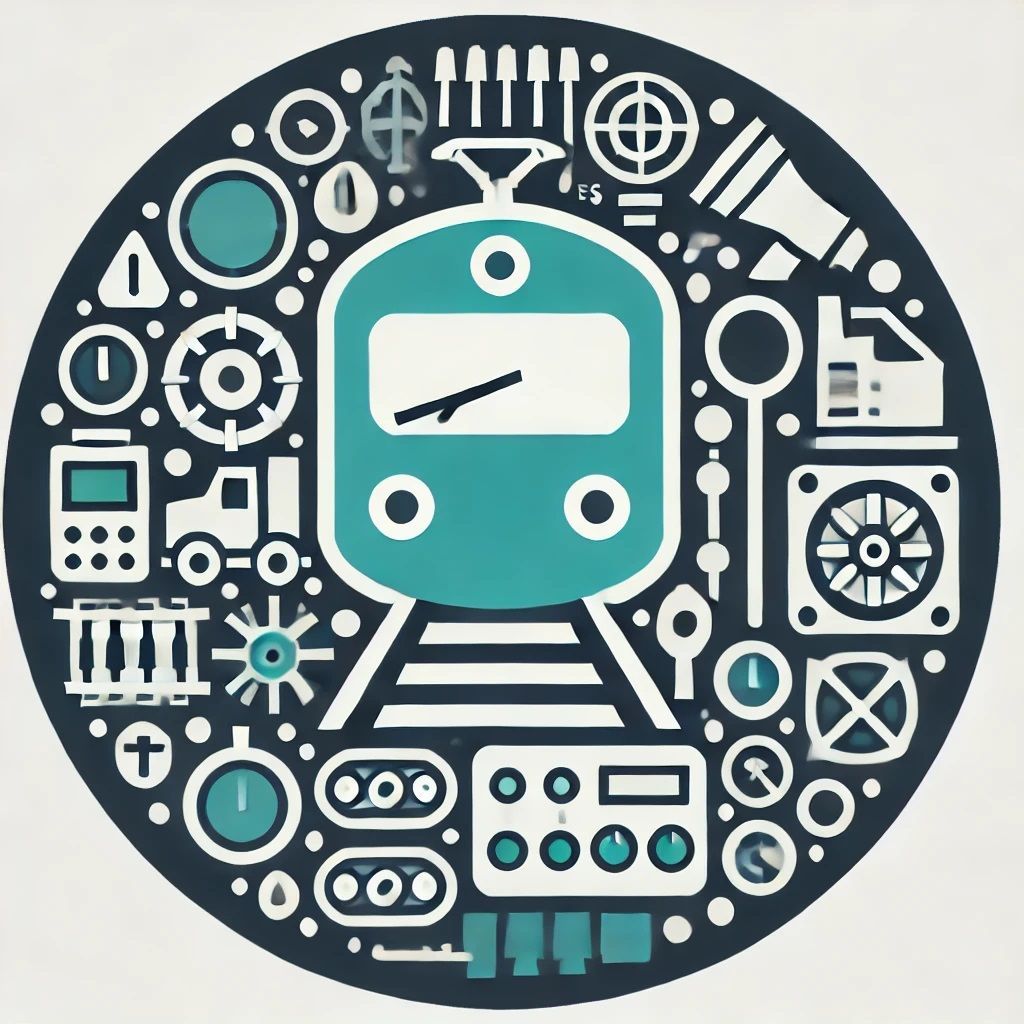
-
Who do train drivers work for?
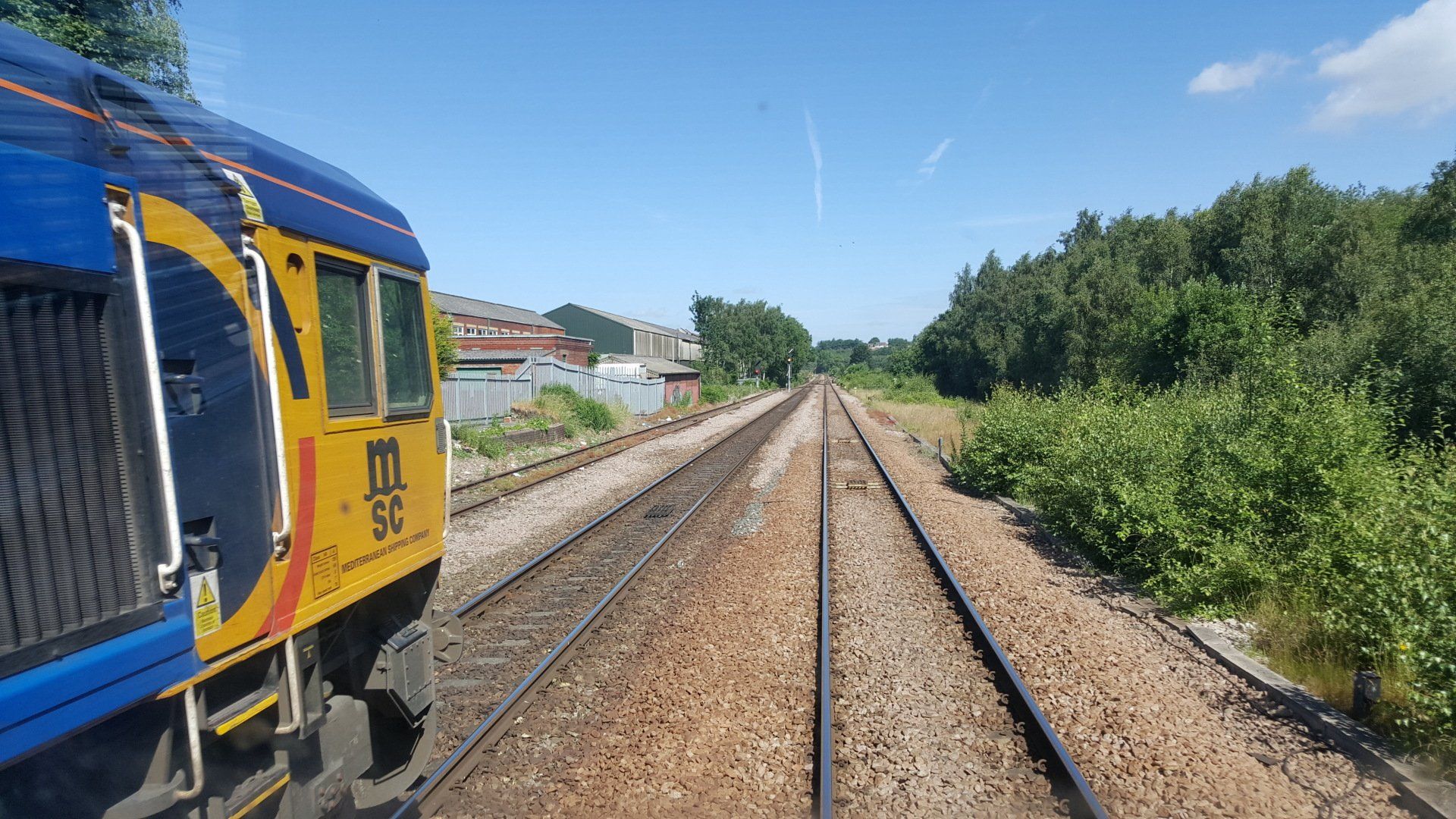
Train Drivers are employed by Train Operating Companies (TOC's) and Freight Operating Companies (FOC's).
-
What types of roles are available?
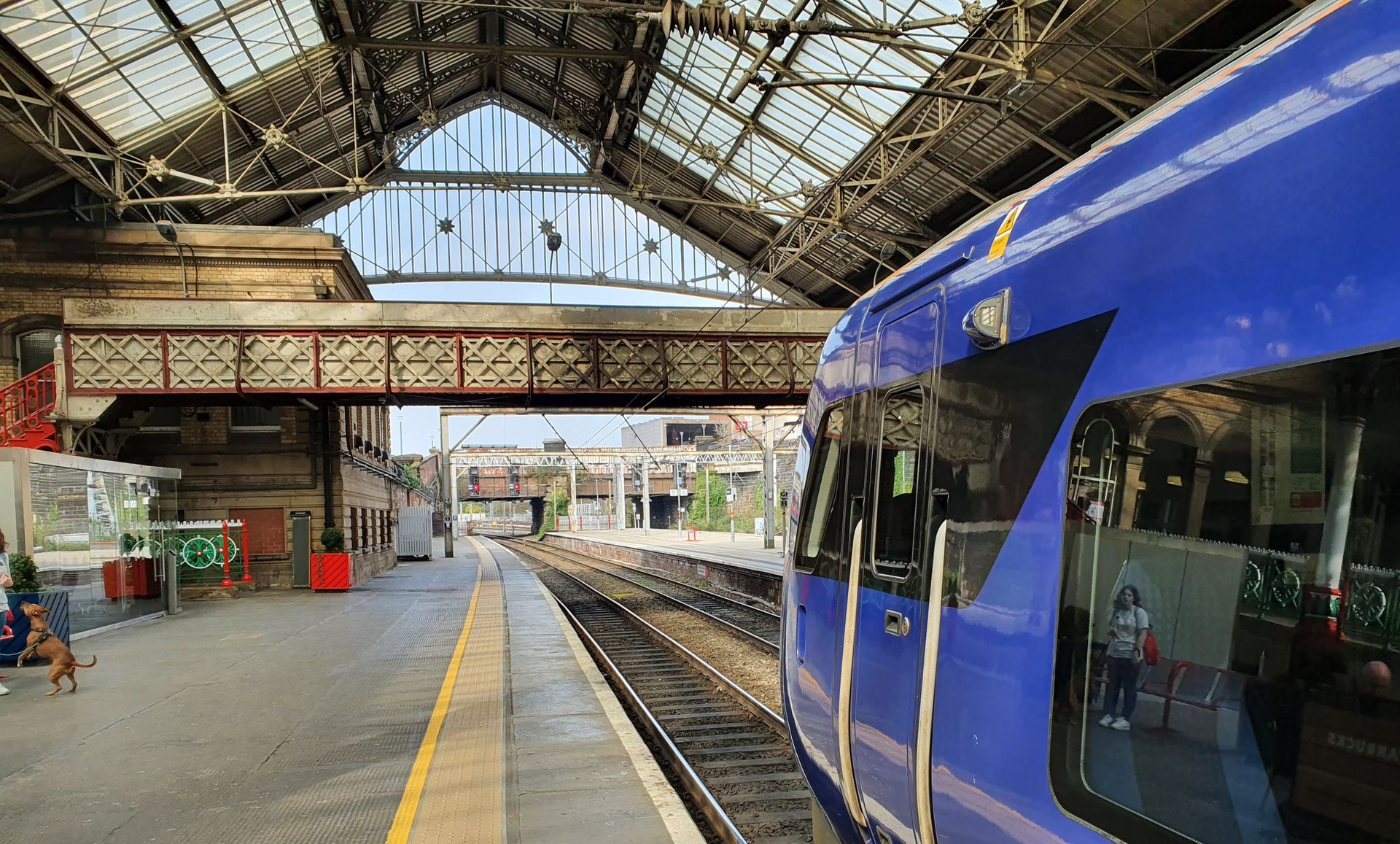
Train Drivers are employed in a variety of roles - passenger services, freight services, dangerous goods, recycling materials, engineering, research, heritage, historical, private and even Royal.
Drivers carry out a range of duties in line with their company's operations.
-
Where do they drive?
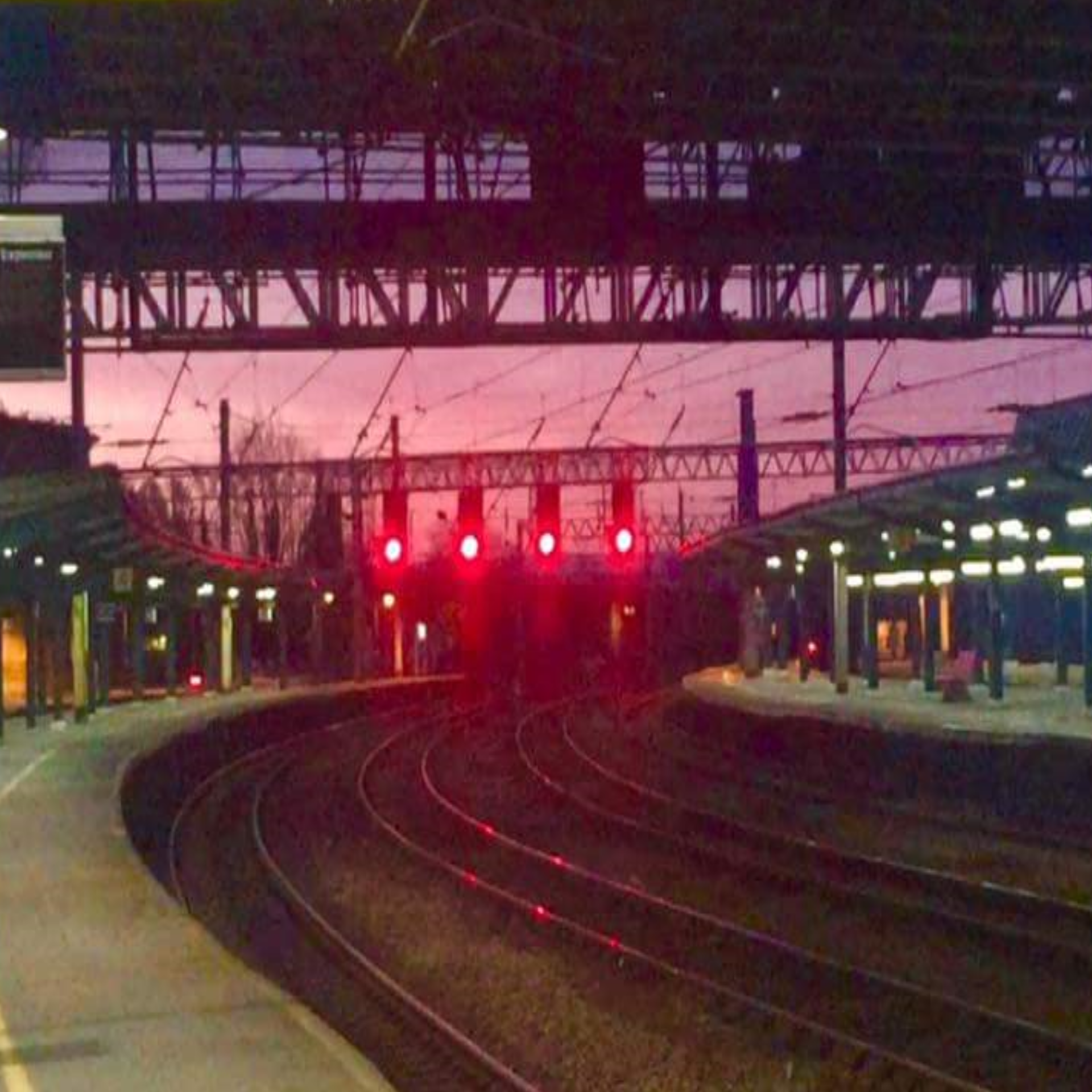
Inter-city, inter-region or even international services connect villages, towns, cities and regions across the UK and into Europe.
There are train drivers that operate only within maintenance depots. They work as depot drivers, fitter drivers and shunter drivers. Sometimes these drivers have maintenance responsibilities too.
Train drivers could also work within engineering work sites called possessions. They drive On Track Machines (OTM).
-
Day to day duties
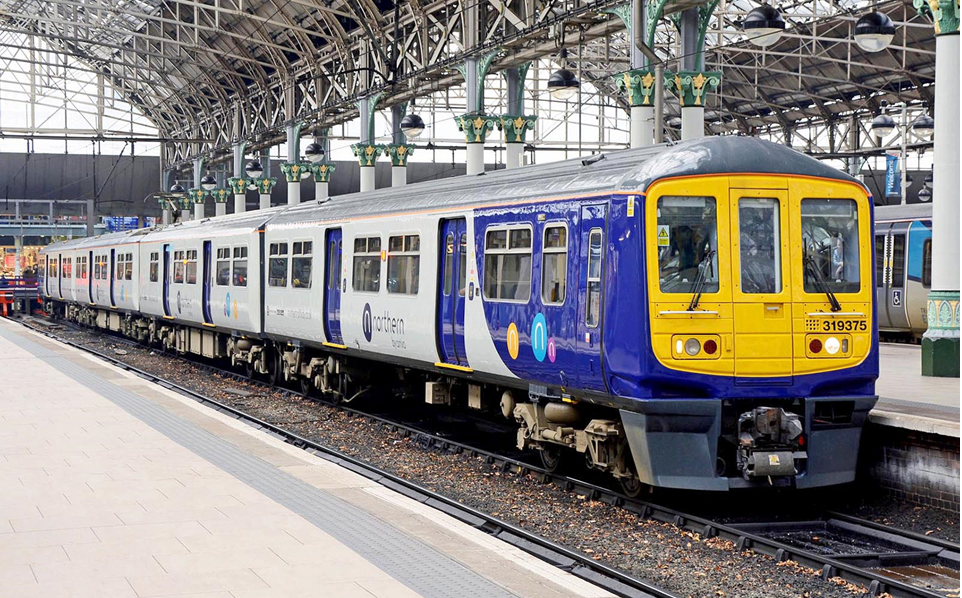
General roles and responsibilities include, but are not limited to:
- Checking controls and equipment before a journey. Preparing trains for service.
- Driving the train safely and punctually between stations or freight depots.
- Speaking with signallers and control centres along the route about any issues.
- Follow track/cab signalling equipment, safety and speed instructions.
- Leave platforms and arrive into stations safely. Manage platform train interface.
- Make passenger announcements.
- Control automatic doors or work in conjunction with other train crew to make sure door operation is safe.
- Position and hand over trains to drivers on the next shift.
- Record incidents like equipment problems, on-board issues or delays.
- Fill in report forms.
- Adhere to Rules and Regulations as well as other industry guidance and company policies.
- Much more!
-
What about career progression?
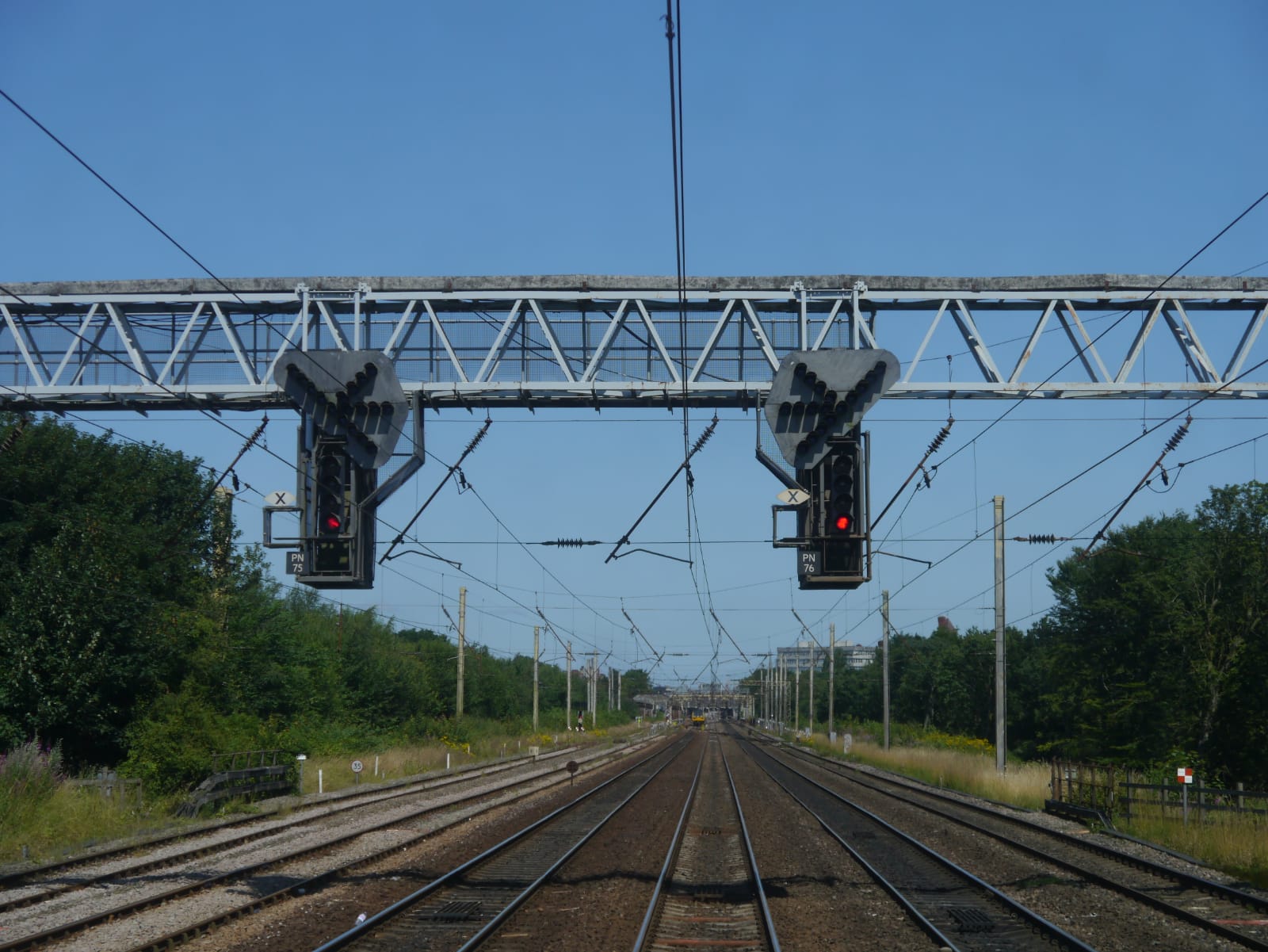
With experience, you could become an instructor or mentor. Instructing trainee drivers, who are learning new routes and cab controls. Instructors also get involved in delivering briefs and sometimes assessments for other drivers.
You could also become a driver trainer, teaching new starters in the classroom, working with driver simulators and accompanying trainees on journeys.
You could move into driver management, supervising drivers and making sure trains and crew are where they need to be on the rail network. Carrying out HR functions such as discipline/absence management. Carry out assessments, competence development activity and incident investigations.
Operations management is another possibility, planning future strategies, managing driver managers and shaping policy.

Slide title
Passenger train waiting to depart
Button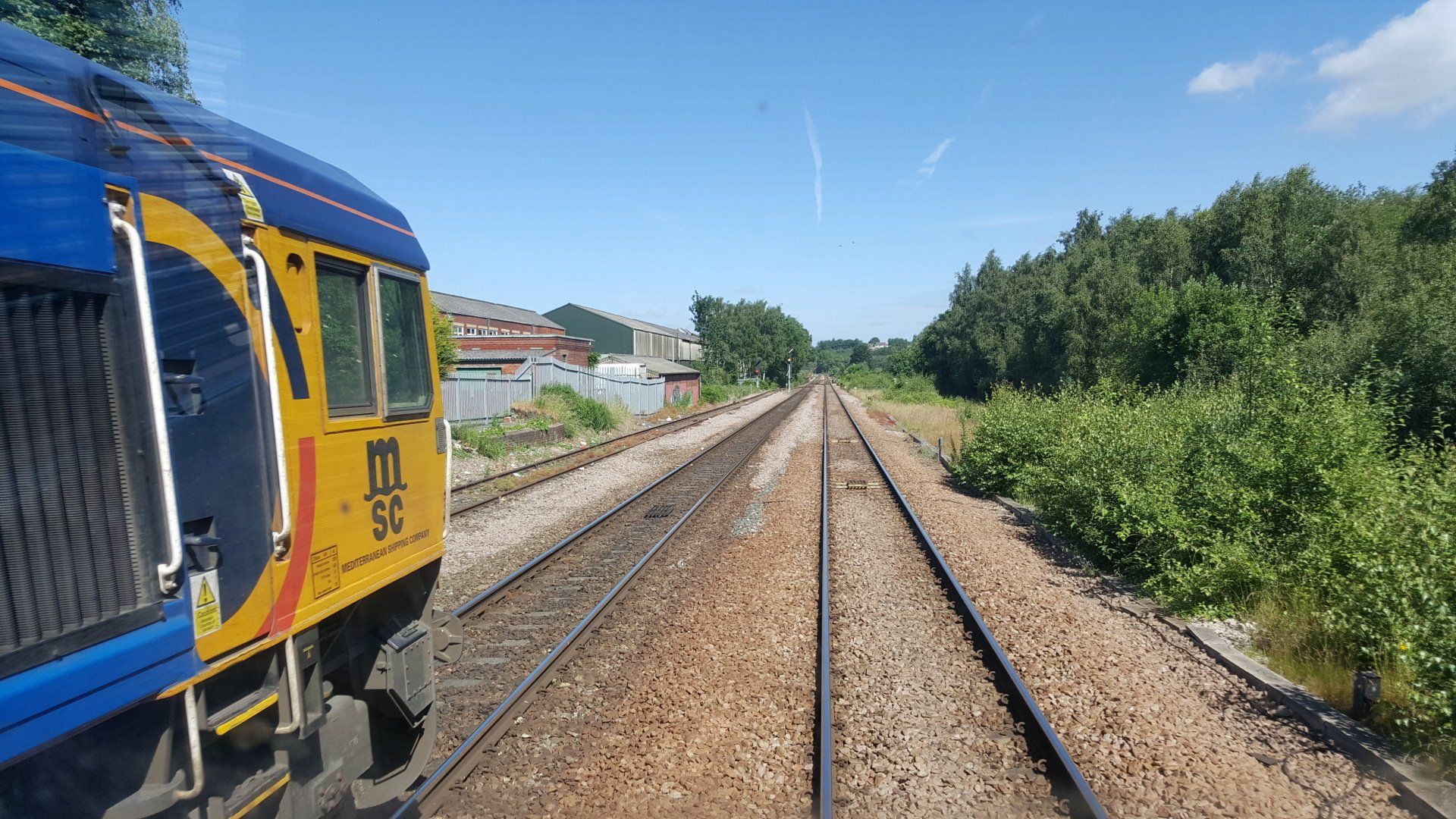
Slide title
Freight Train on the move.
Button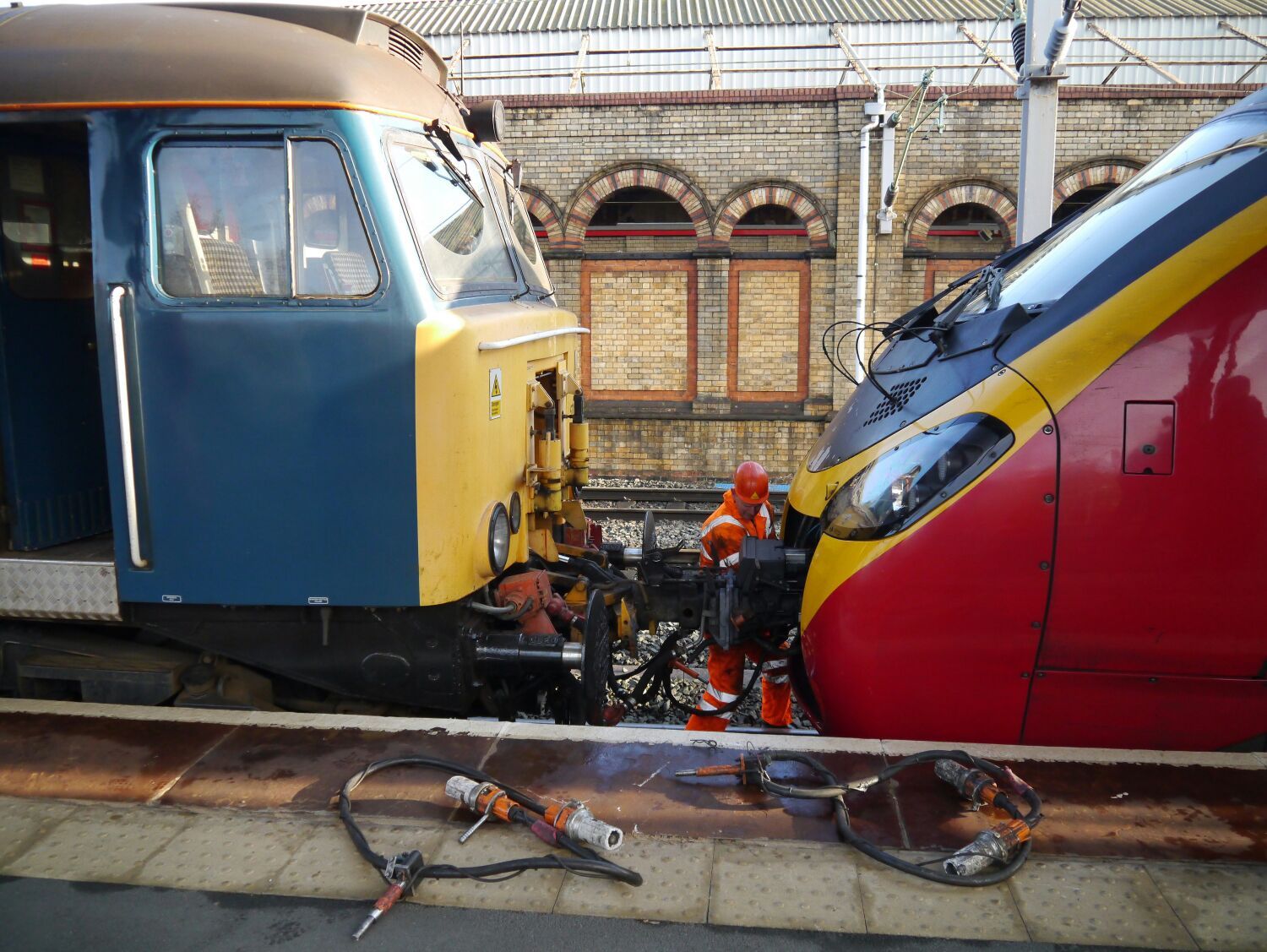
Slide title
Locomotive assisting a passenger train.
ButtonSlide title
Passenger train on a depot.
ButtonSlide title
On Track Machine (OTM).
Button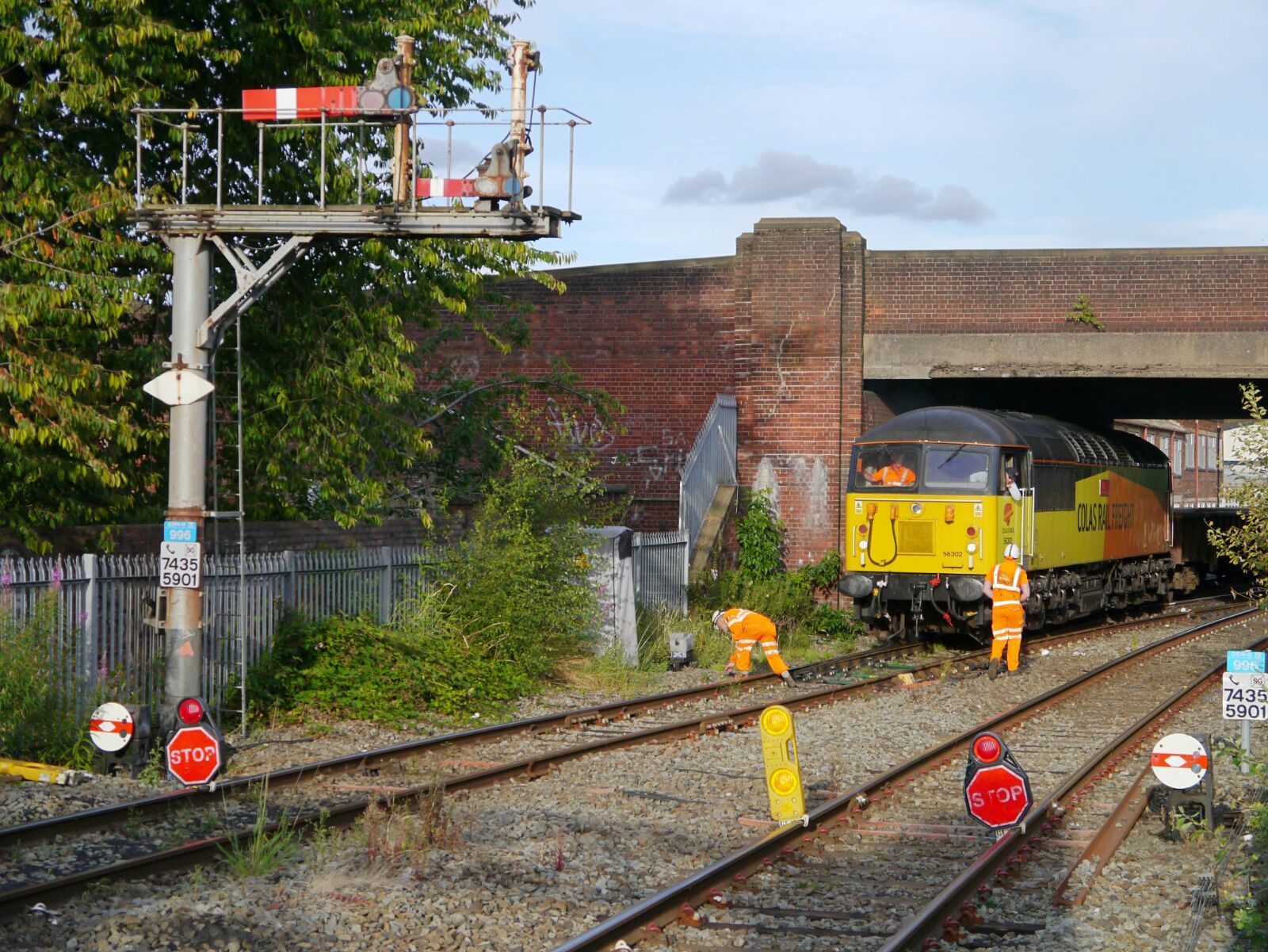
Slide title
Engineering train in a worksite.
Button
-
The cab environment
Explore a typical cab environment. Interact with hot spots to learn more about some of the key train systems drivers use in their day to day duties.
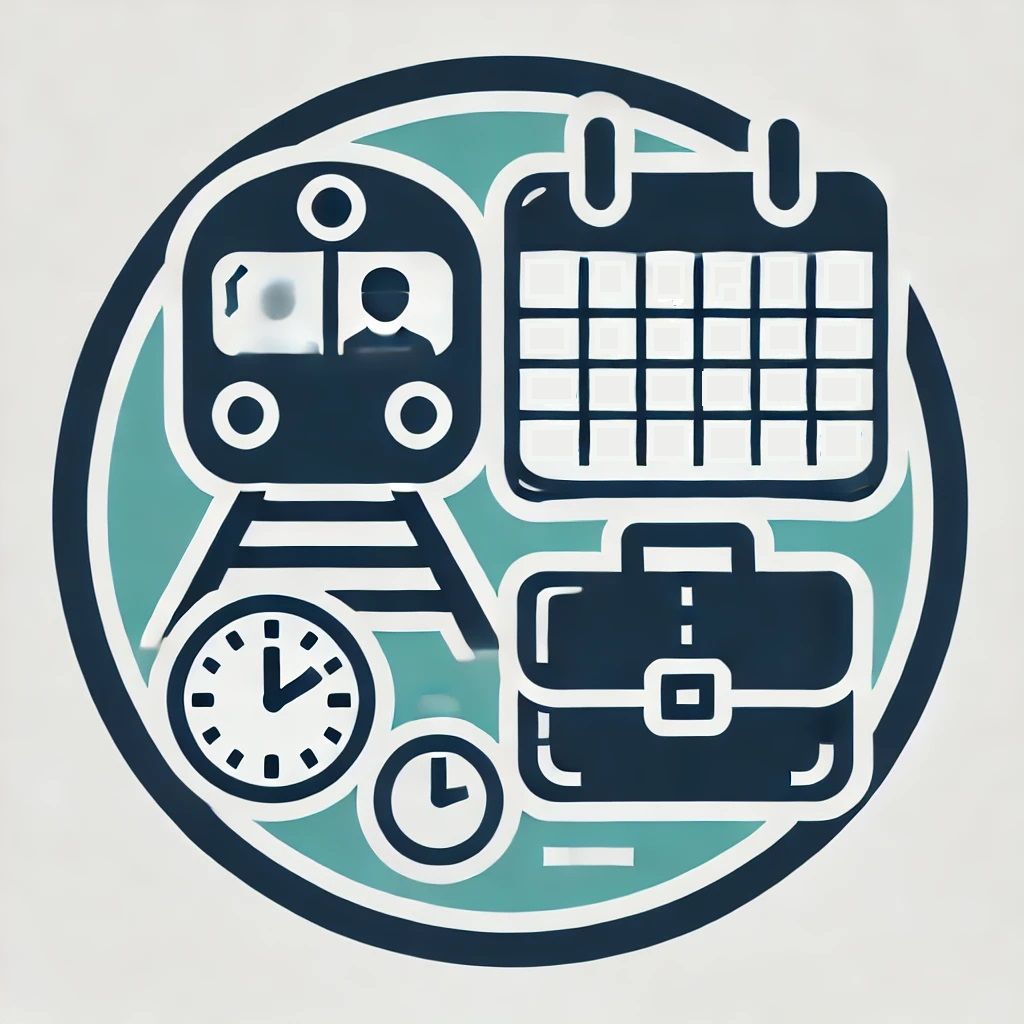
-
Working hours
With regular scheduled train services meaning a planned timetable, passenger Train Drivers work reasonably predictable shift patterns. On average, most operators work to a 35 hour week. Although some work more. A 35 hour week which is generally averaged out over the whole year, shift cycle or similar. For example week 1 = 32 hours, week 2 = 39 hours and week 3 = 34 hours creating a 35 hour average.
Shifts or "turns" generally range from around 6 hours to around 11 hours and vary from company to company.
Some companies operate their turns over a 4 day working week. Days where you are not required for duty are called rest days (RD). Some operators have a fixed pattern of rest days and some do not.
Working includes weekend and bank holidays and may/may not include Sunday as a normal working day.
Shift patterns include very early starts and very late finishes - generally a week of early turns followed by a week of late turns.
Some turns are flexible and can be moved earlier or later depending on requirements - for example you may be allocated a "spare" turn of 0600 (6am) but due to another driver booking sick their service now needs to be covered. Your turn may be moved a number of hours earlier or later to accommodate. Most operators have a number of these spare turns per in their shift pattern. Some have whole weeks where drivers are considered spare.
Many operators will also require you to work an extra hour after your turn to enable you to attend incident interview or fill in report forms.
The amount of hours you can work in any shift is 12 although the average is around 10. A driving turn of around 10 hours, may only include as few as 5 hours actual driving. This is to ensure break times, train schedules and staffing requirements are maintained. Everything is carefully planned to the minute.
You can work 72 hours in any one week period. You are also able to work 13 consecutive days in any 14 day period. There must also be 12 hours between the end of your turn and the start of your next. Working on your rest days is often paid at considerable overtime rate. Overtime working is often allowed under agreements with recognised Trade Unions.
Freight drivers will generally work many more hours. There is also a greater frequency of night work. Those freight depots which carry out engineering work for Network Rail also have a high amount of weekend working, a lot of which is at night. Some InterCity and most freight operators require some overnight lodging. You may have to stay in a hotel away from home between shifts. This is generally kept to a minimum because of cost implications.
Overtime - if allowed within your company (can change from time to time). Working on your days off must also not exceed the working hours as described above. This type of working is voluntary. If you decide to work on one of your Rest Days (RD) or Off Days it is often paid as a multiple of your normal hourly rate or as a fixed amount. Working on Christmas Day or Boxing Day (if available) can attract 3x your hourly rate!
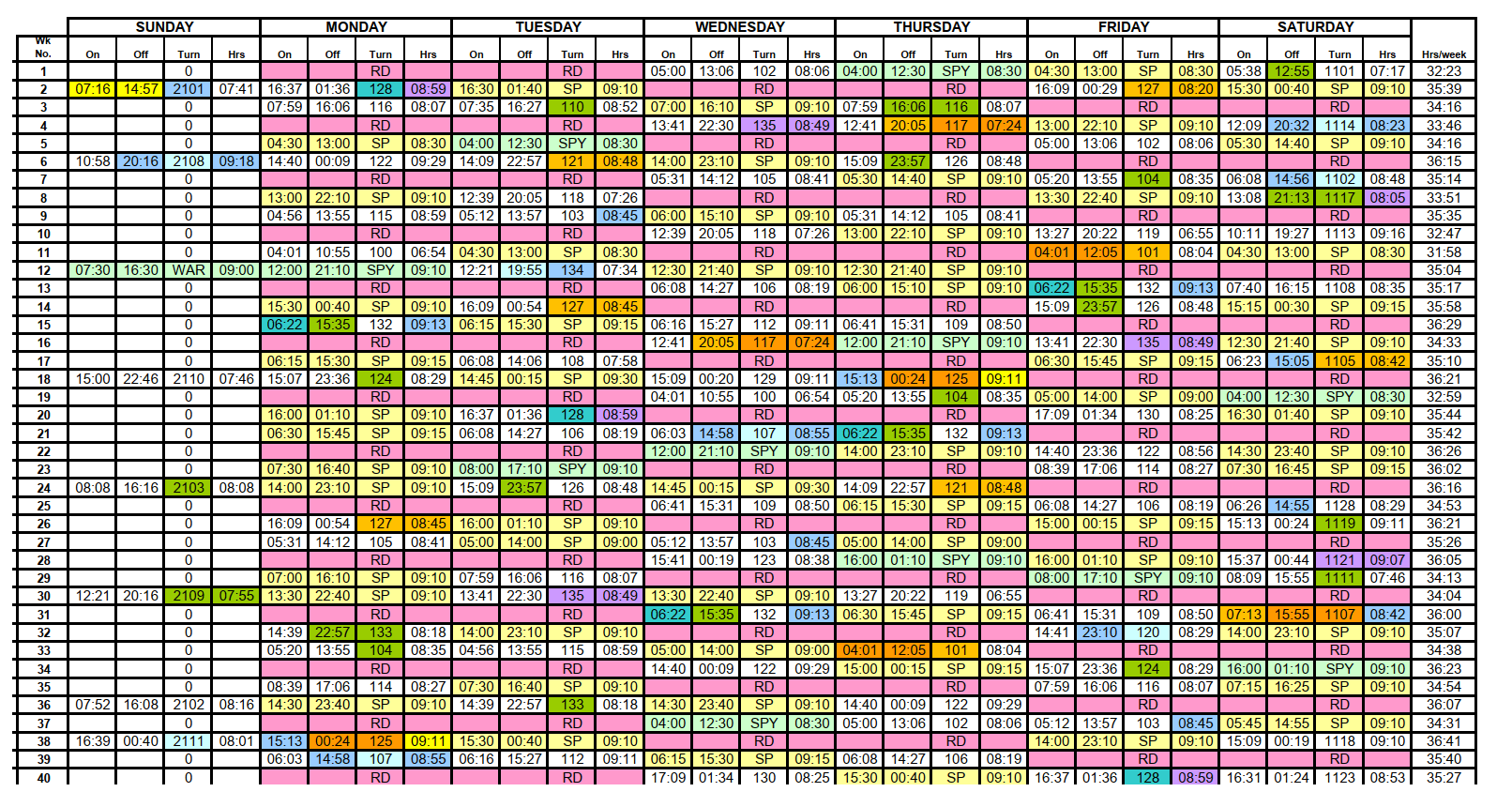
Typical link or shift roster.
Button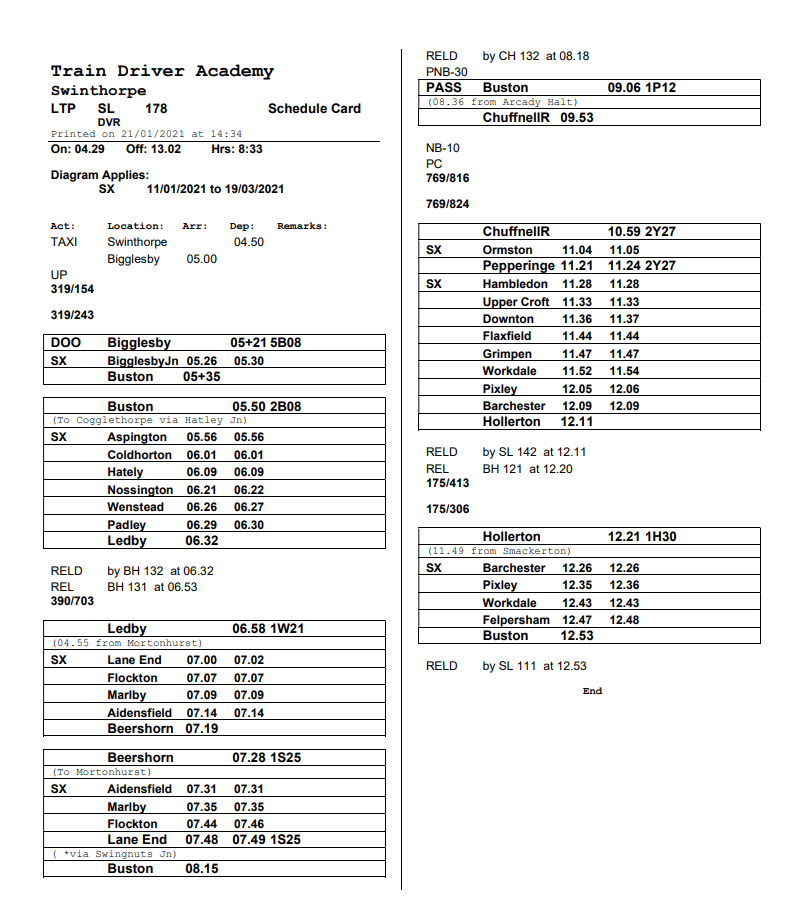
Slide title
Typical schedule card - what a driver works to during thier shift.
Button
-
Day to day activities
Normal Operations
Regardless of your company, the primary role of a train driver is to safely operate the trains they run, and to maintain the safety of the line on which they operate. This is referred to as a "Safety Critical" role.
Trains operate to a timetable and after safety, maintaining good time is also part of the role. Customer service is an integral part of a train driver's duties as is looking after your load or cargo.
Some operators utilise other grades to prepare trains for service, while others require the driver to prepare the train. As such, it is important to have a good mechanical and electrical aptitude and be able to understand and maintain technical knowledge.
At the start of your turn you will have to ensure that you have all relevant equipment and publications needed for your role. You will also have to adhere to strict industry and company regulations with regards drugs and alcohol, medical requirements and lifestyle responsibilities. You also have to ensure that you are within the working limits as outlined above. Train driving can be mentally challenging, with both overload and under-load frequently experienced. As such you will need to be well rested with plenty of good quality sleep.
On arrival at the workplace Drivers have to book on for their turn. This may be face to face or via telephone or electronic swipe card. Once you have booked on you will need details of the turn you are working. Many operators use paper copies to show a days workings - these are termed schedule cards, dockets or diagrams. Some operators have mobile or other electronic devices for this. Your schedule card will outline everything in minute by minute detail. Even seemingly minor details such as the time it takes to walk from the booking on point, down to the station platform are carefully planned. You must also read various notices that relate to your duties. Driver's also have to receive, read, understand and update a variety of publications. Some must be carried at all times.
After booking on you may have to prepare your train, or prepare your driving cab for service. Each of these processes is detailed in company instructions as well as regulated by industry bodies. Some procedures are fairly complex and will require you to have a thorough and systematic approach to completing them. Failure to correctly carry out these duties could ultimately lead to accidents or incidents. Examples of procedures could be to carry out tests on your trains braking systems, setting up communication equipment or dealing with advanced train control systems.
You may operate a wide variety of train types within your company. Some operators have 12+ different train types - each requiring a full understanding of their systems and operating characteristics.
There can be old or new, trains diesel trains, electric trains that run of overhead wires, electric trains that run of electric rails and even bi-mode or tri-mode trains(diesel and electric hybrids). You will also be required to learn and operate over a variety of routes. For each route you will learn the method of operation, signal locations, station names and locations, platform lengths, operating restrictions, local instructions, speeds, junctions, risks, level crossings and more. we call this route knowledge and it underpins a great deal of our operational knowledge.
For the vast majority of the time, Train Drivers operate under normal working conditions. You experience times of mental load - such as complex station and junction areas. You will also experience significant under-load. Times when you may travel for miles without much visual or audible stimulation. We have to develop strategies to enable us to heighten our concentration when needed and lower it when conditions allow.
Slide title
Signals control the normal movement of trains.
ButtonSlide title
Drivers need to understand the meaning of many indications.
Button
Slide title
Sometimes signals can be difficult to see.
Button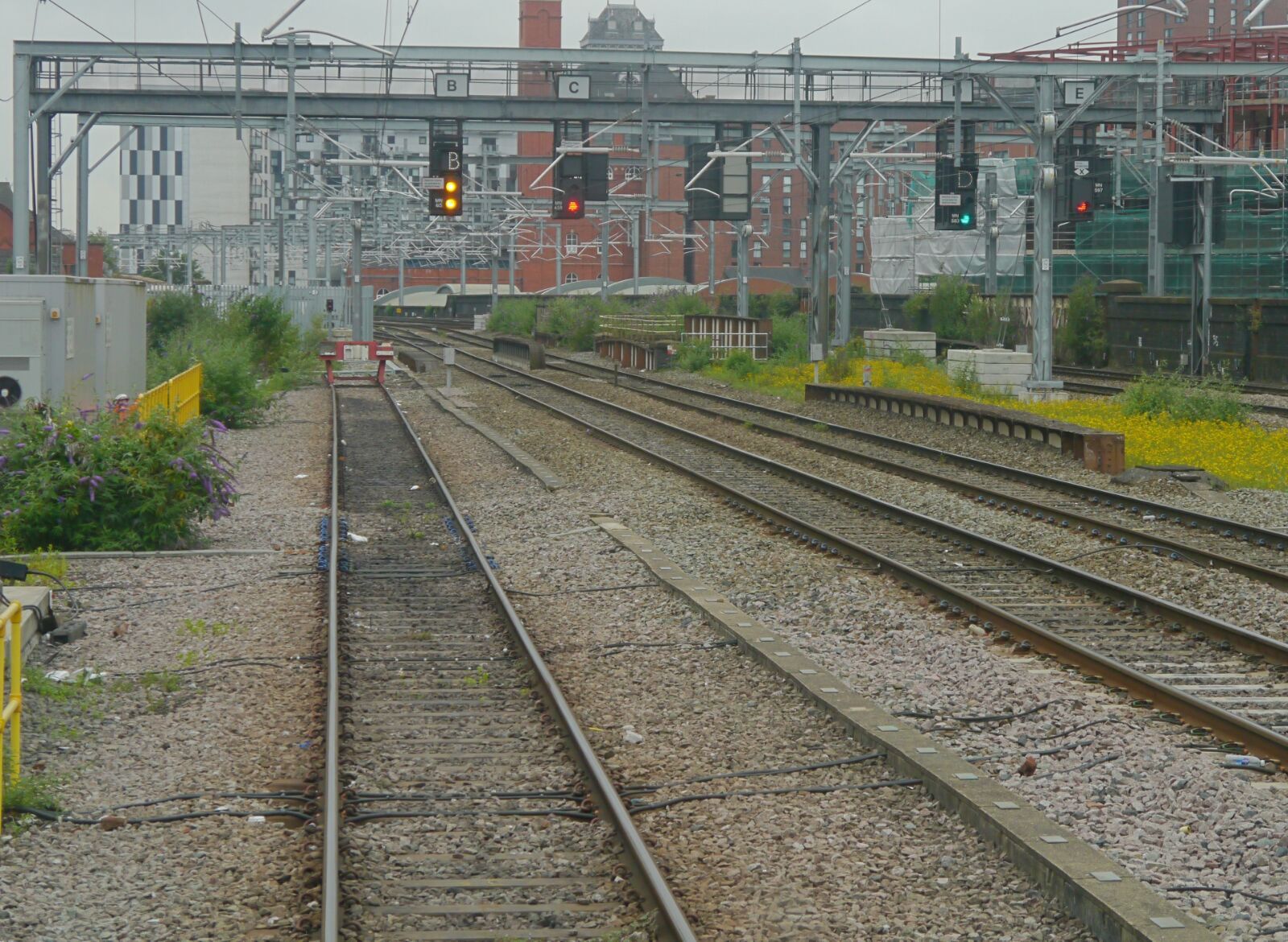
Slide title
Drivers must have excellent route knowledge.
Button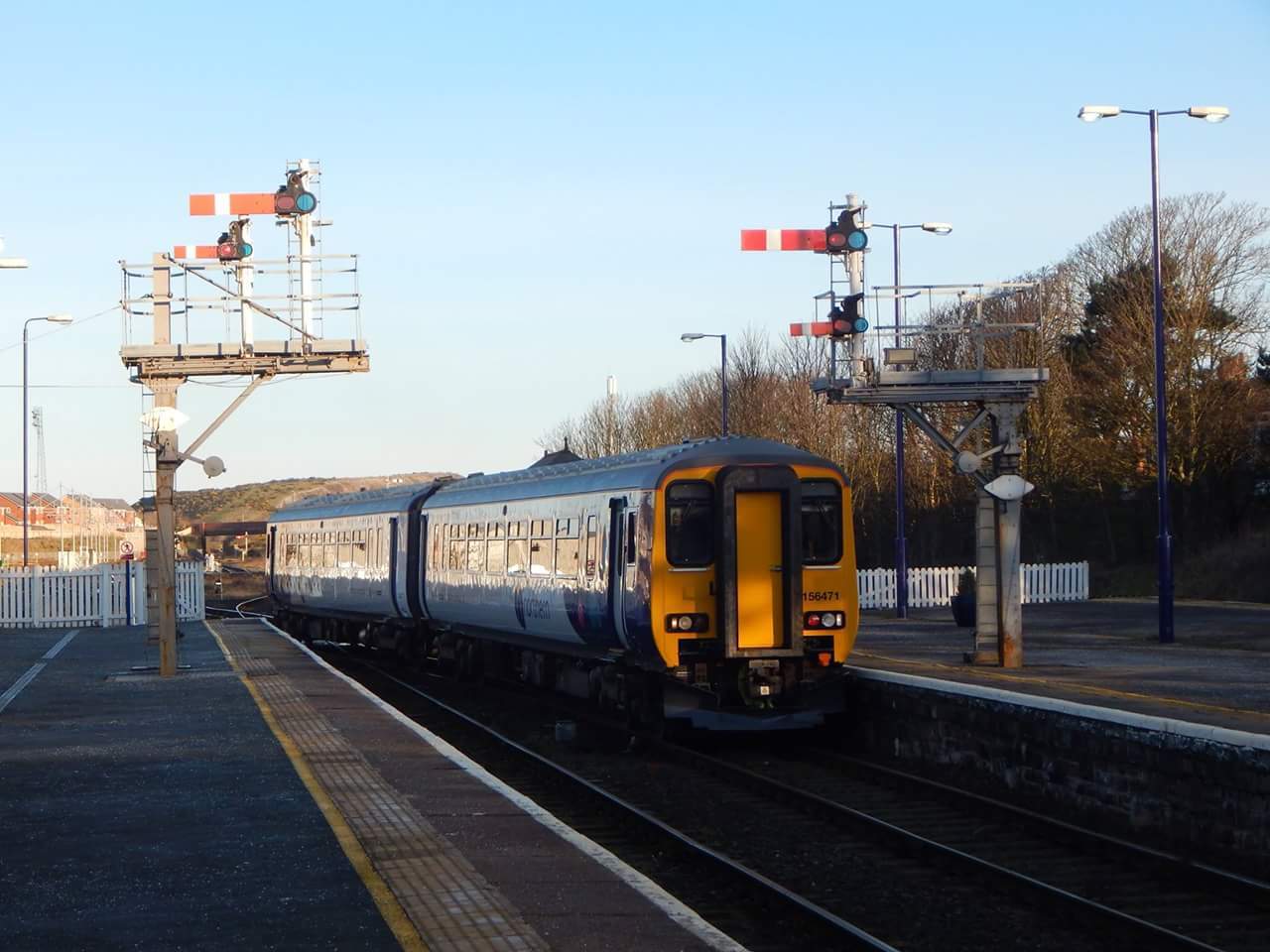
Slide title
Train drivers operate under many different signalling systems.
Button
-
Degraded working
There may be times when we have to operate in challenging, degraded working situations. Dealing with everything from equipment failure, fires, obstructions, dangerous goods incidents, electrical emergencies with high voltages, level crossing dangers, suicides and more. Train drivers must be able to keep their cool and deal with these situations in a logical, methodical and disciplined manner. Fully using their knowledge and understanding of complex rules and regulations with safety as the top priority.
Before heading home, train drivers must book off duty. This is generally checking your next turn of duty and submitting any report forms as necessary. Time to head home for some well deserved rest ready for your next turn.
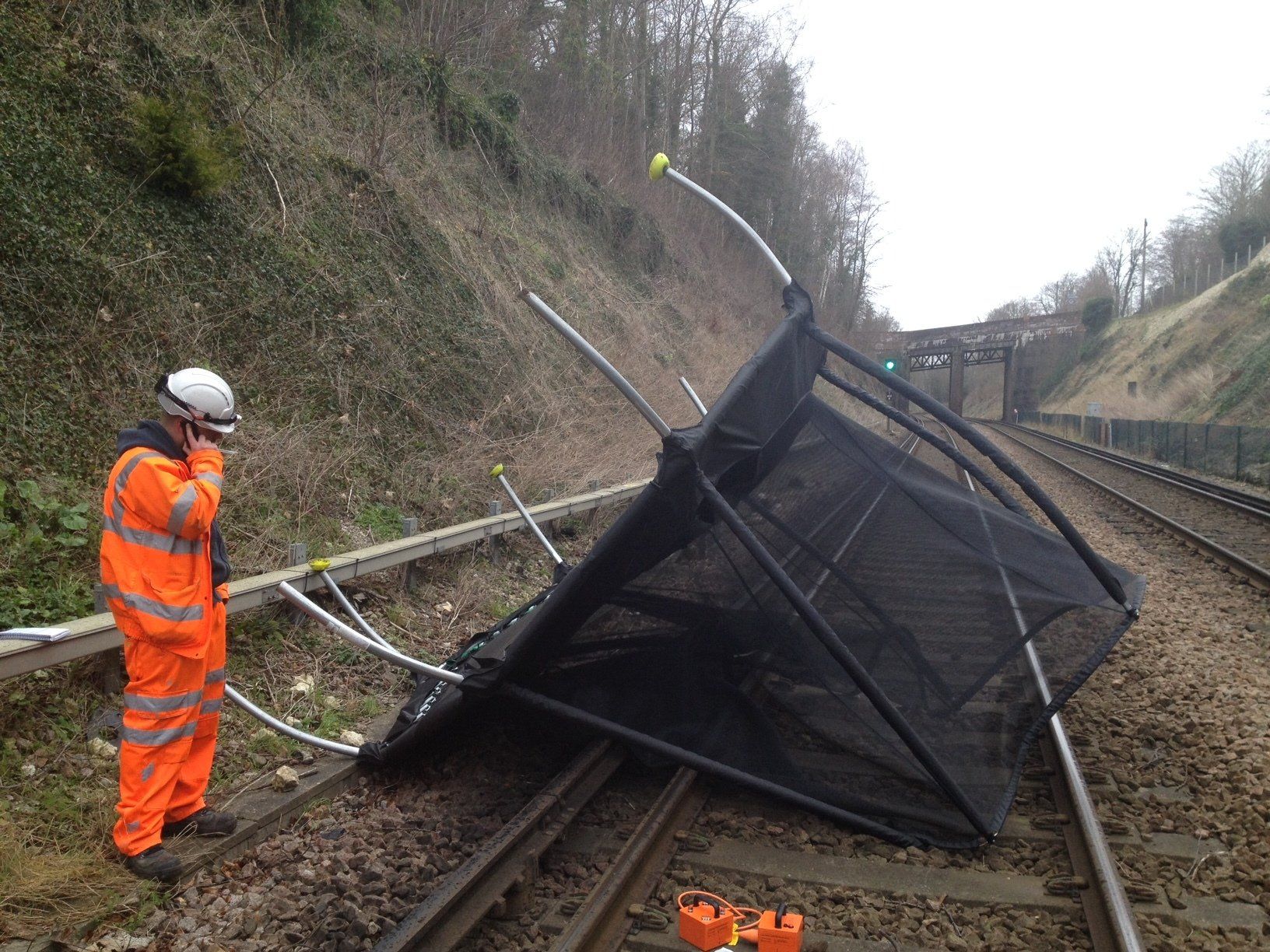
Slide title
Obstacles on the line are a real risk.
Button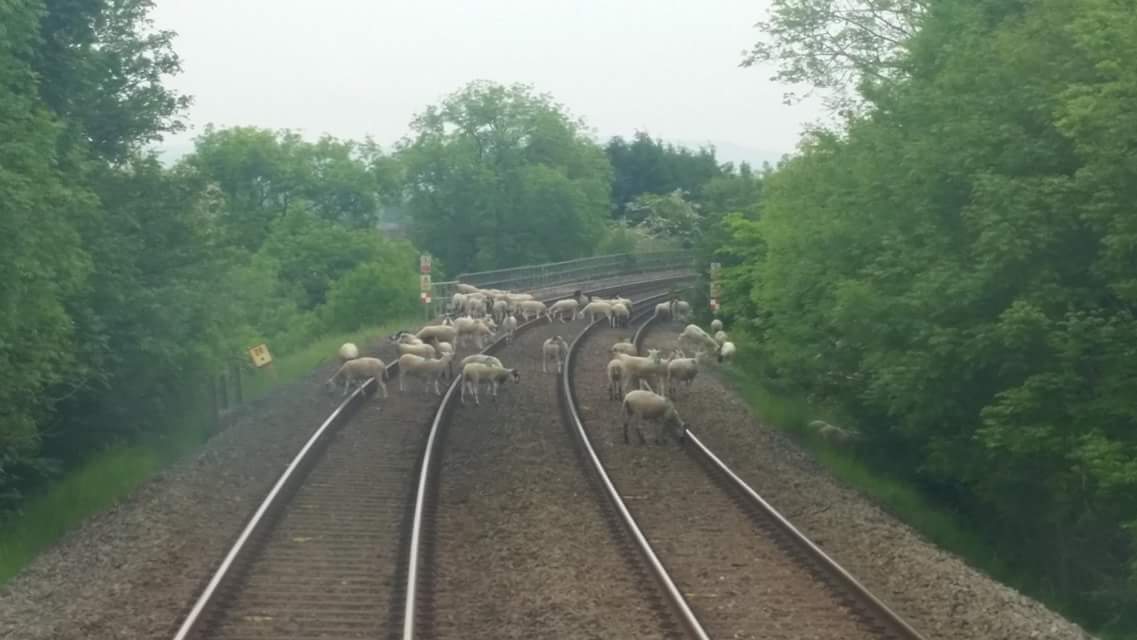
Slide title
Animals can also cause serious incidents.
Button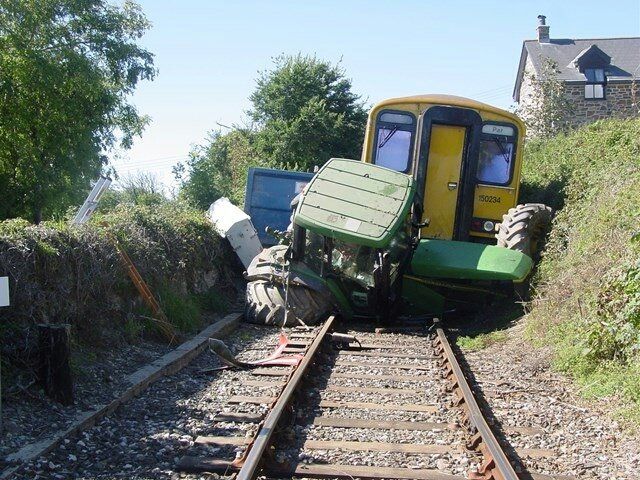
Slide title
Level crossing misuse endangers lives.
Button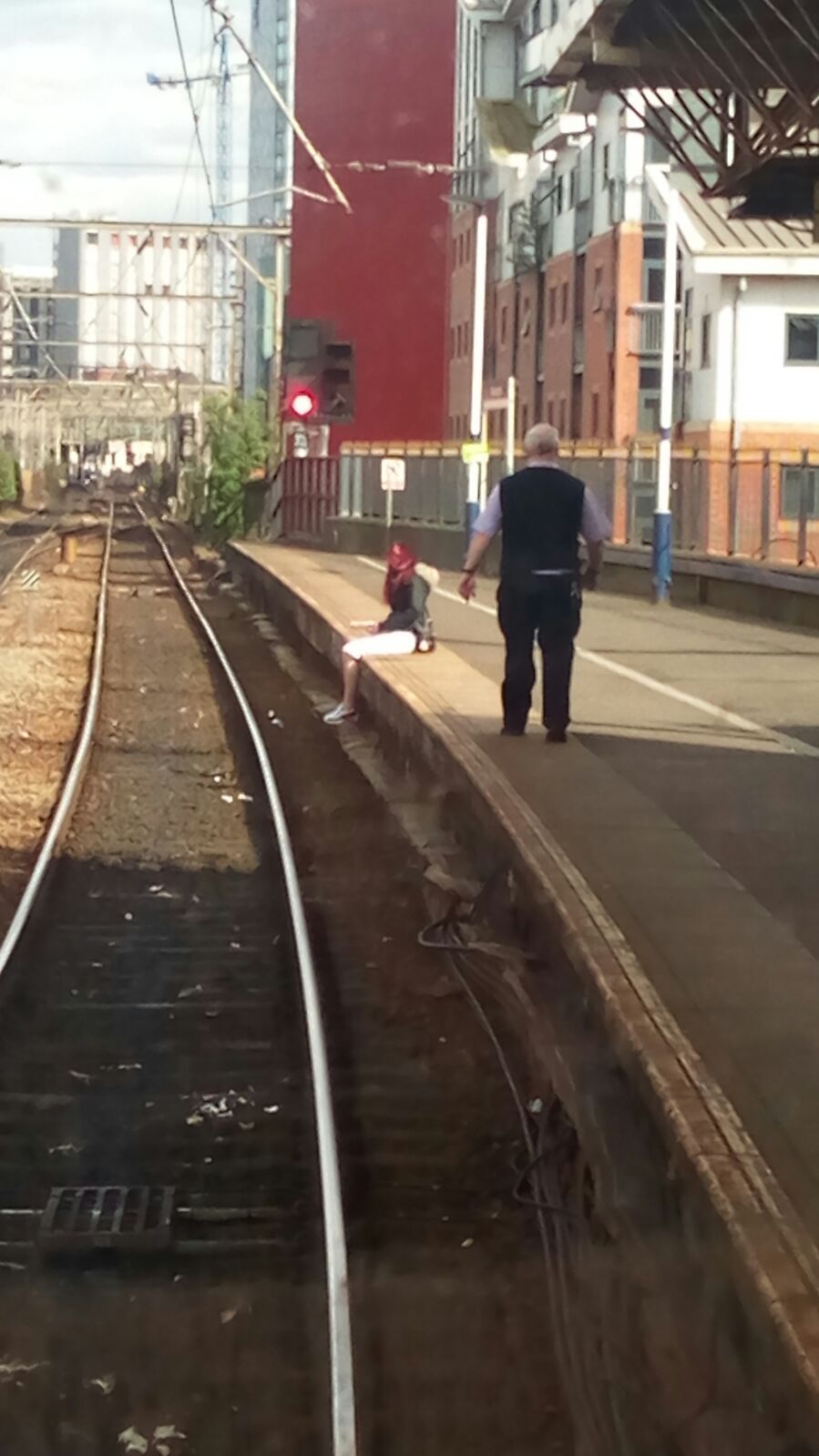
Slide title
Suicides are reletively uncommon but can affect many lives.
Button
Slide title
Stormy weather can cause serious incidents.
Button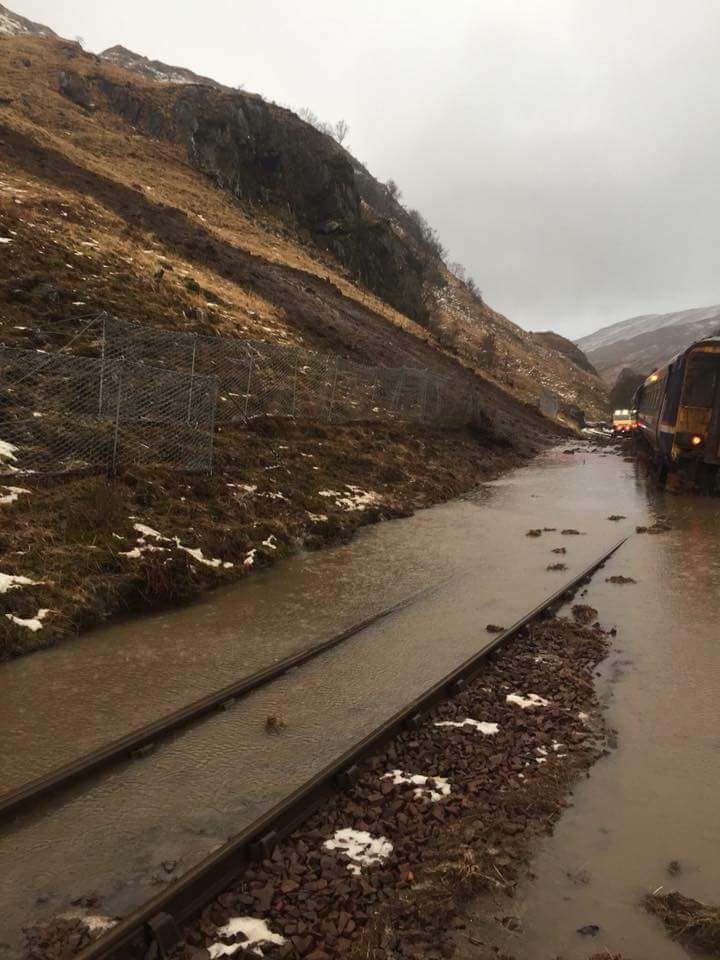
Slide title
Flooding and landslides can occur after heavy rain.
Button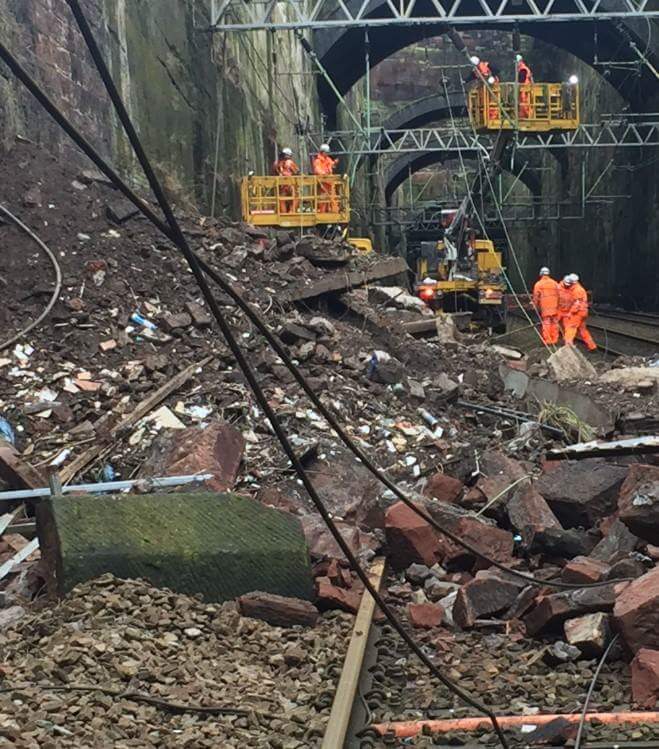
Slide title
Infrastructure collapse.
Button
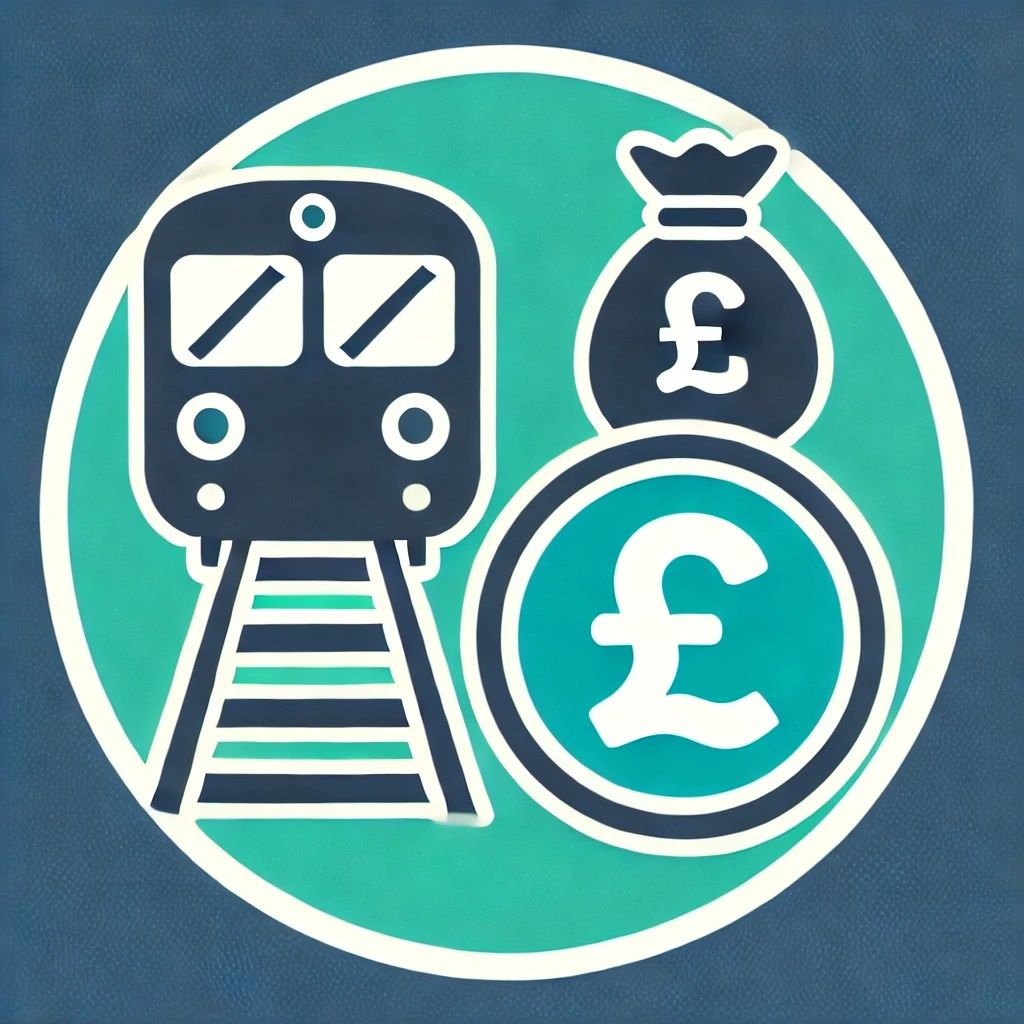
-
Salary expectations
As an Apprentice or Trainee Driver you are likely to start on a training salary of around £20,000 - £25,000 or higher.
This will increase in line with various factors. There may be an increase upon the anniversary of date of employment or as a result of reaching certain milestones. These milestones could be the number of, or percentage of, routes and train types you are able to drive.
There may be more than one stepped increment to your salary progression. For example you could see year 1 salary of £23,000, year 2 salary of £36,000, year 3 salary of £48,000 and year 4 salary of £55,000. This is for illustrative purposes only. Some companies only have two progressions - training salary and qualified salary.
Averaged out over all Train Operating Companies the average salary for a fully qualified Train Driver is £57,137. This is not inclusive of any overtime earnings or Sunday work - both of which would be paid overtime (some TOC's have Sunday as part of a normal working week so wouldn't attract overtime).
Typically, the Train Driver grade has seen above inflation pay increases year on year. These are obviously tied in to many factors such as revenue generation and passenger numbers. It is not unusual to see 2% - 4% increases every year. Sometimes these increases come as multi year pay deals. An example may be 6% over 2 years. Pay rises may also occur if productivity deals can be reached. This would involve trading certain terms and/or conditions in return for a pay increase.
-
Pensions
In general, Train Drivers are members of the Railways Pension Scheme (RPMI). It is also generally the case that salary figures are calculated using favourable Defined Benefit (DB) scheme rules. This sort of scheme works out your pension using your final salary and number of years in the scheme. Generally, the maximum years you could pay into the Railway Pension Scheme is 40. Normal retirement age is considered to be 62. You can often retire early (age 55) but will forfeit a proportionate percentage of your pension as a result. Pensions are taken as a combination of lump sum and yearly pension. You can also often trade in each £ of lump sum to purchase additional £ of yearly pension and visa versa.
In addition to your pension you will also have to opportunity to voluntarily pay into Additional Voluntary Contributions (AVS's). These are used to buy units in various pension managed funds and are affected by market forces. These benefits are collected upon retirement in the form of a lump sum. Traditionally, AVS contributions have returned favourable returns for their investors.
Some operators offer private pensions that are generally not as generous as final salary or defined benefit schemes.
-
Holidays and leave
Leave usually consists of a number of weeks that are dictated to you. It is normal to be allocated a week leave in the first 3rd of the year, 2 weeks summer leave, and a further week in the last 3rd. You would also usually receive lieu days or individual days. These can be applied for at any time but are generally only approved if there are under a certain number of drivers already on leave that day.
An example leave arrangement may be 24 days. 16 days are allocated for your pre-rostered annual leave as detailed above (assuming a 4 day week). This would leave you with 8 lieu days to be taken at any time. This equates to 2 weeks. It is often possible to swap leave with other drivers. For example, a driver who has a young family may want leave in the school summer holiday, where a driver with an older family may not.
It is usual for Train Drivers to have Christmas and Boxing Day off work. All other bank holidays are considered part of the working week. However, the public and industry would like to be a 365 day railway in the future.
-
Other benefits
Most TOC's offer free standard travel on their own services for you and your family. It is also usual for you to be able to book heavily reduced fares on other TOC's. This is currently 75% off.
Many operators have free reciprocal travel arrangements with other operators.
After 12 months service you may also be able to take advantage of free European rail travel.
Access to company health services such as physiotherapy or mental health support is also common.
Pros and Cons
The lists below are non exhaustive and intended to provide points to reflect on as you make important career choices. Some people may see some of the items in the cons list as plus points and visa versa. When applying it is important to try and research how your chosen TOC/FOC operates.
+
- Great work life balance
- Potential to see a lot of the country
- Modern trains
- Best in class pensions
- Some shift patterns make planning easy
- Potential for overtime earnings
- Excellent salary when qualified
- Good prospects of career progression
- Job Security
- Associated benefits such as free travel
- Generous leave
- Once you have a Train Driving Licence it belongs to you
- Good working terms and conditions
- Industry that is investing £££
-
- Work weekends and Bank Holidays
- Potentially limited routes
- Old and out dated trains
- Work early and late shifts
- Some shift patterns make planning difficult
- Moveable spare turns make planning difficult
- Working alone
- Training salary
- Time it takes to train and qualify
- Large portion of leave pre allocated
- Potentially dangerous
- Limited to locations within 45 minutes
- Can be monotonous at times
- Work can become repetitive
Ready to apply? Want to more about the application process? Press the button to find out!
Want to know more?
If you have questions about the role of Train Driver, please use the form to get in touch.
Get In Touch
Thank you for your enquiry. A member of the team will get back to you as soon as possible.
Oops, there was an error sending your message.
Please try again later.
All Rights Reserved | Train Driver Foundation

